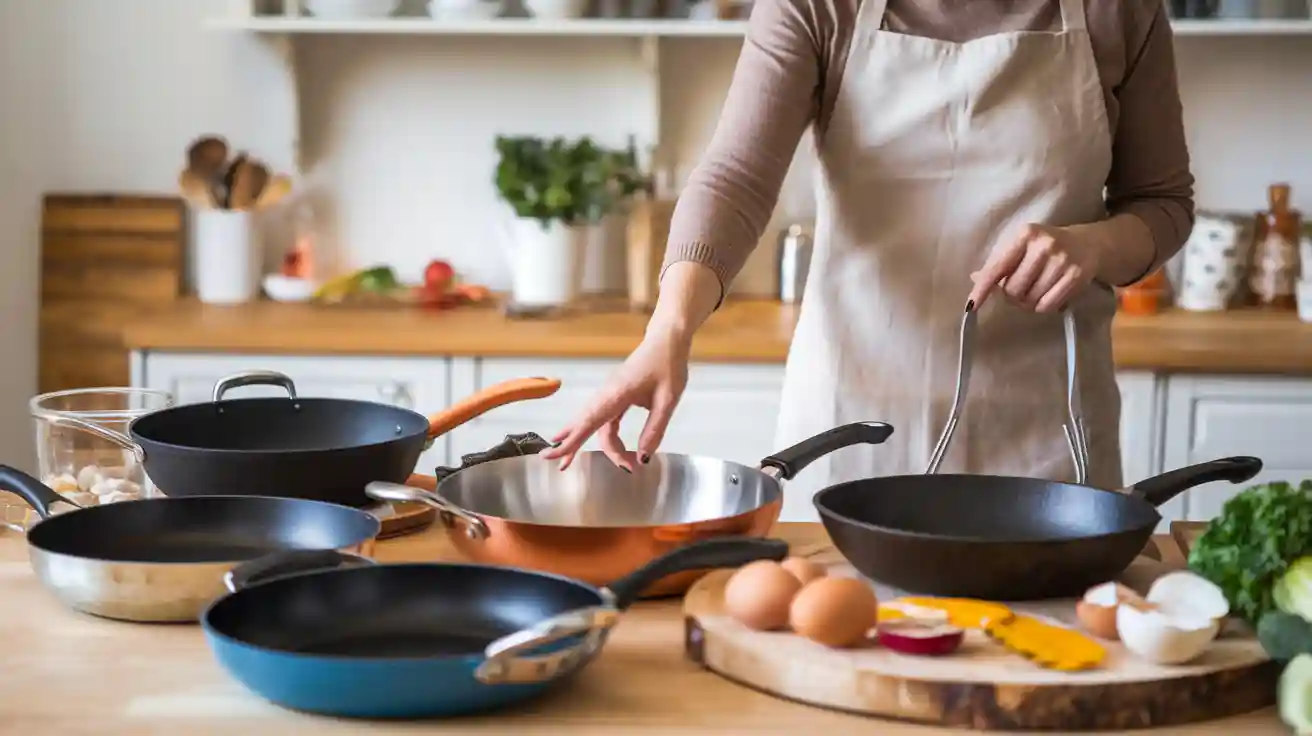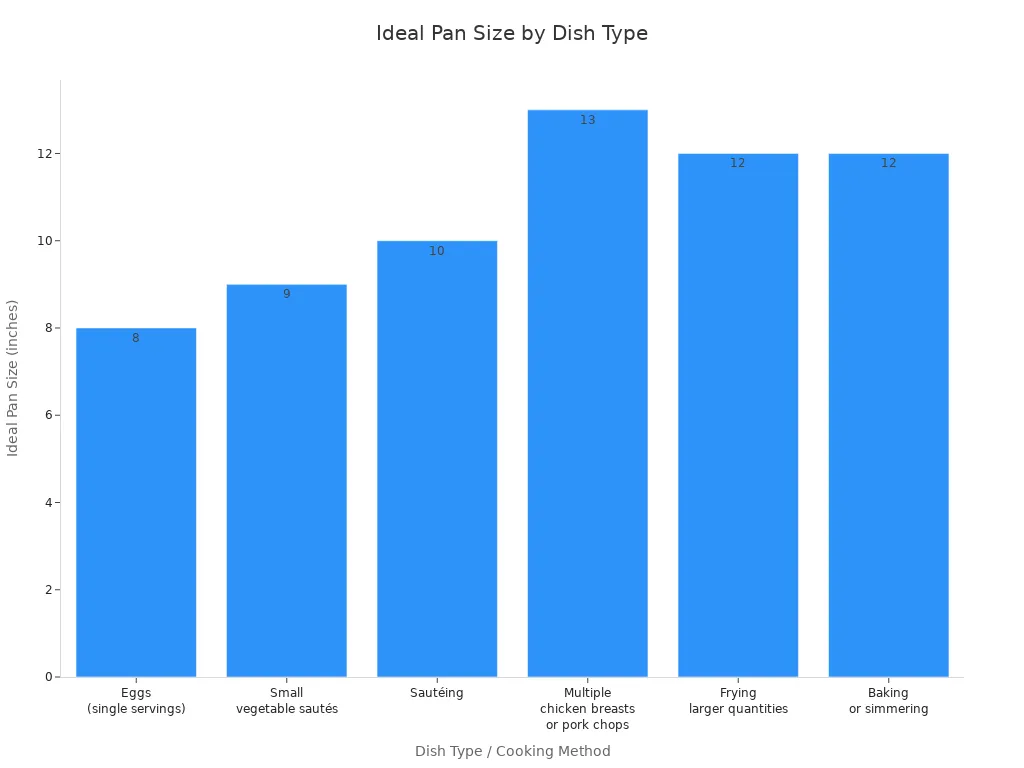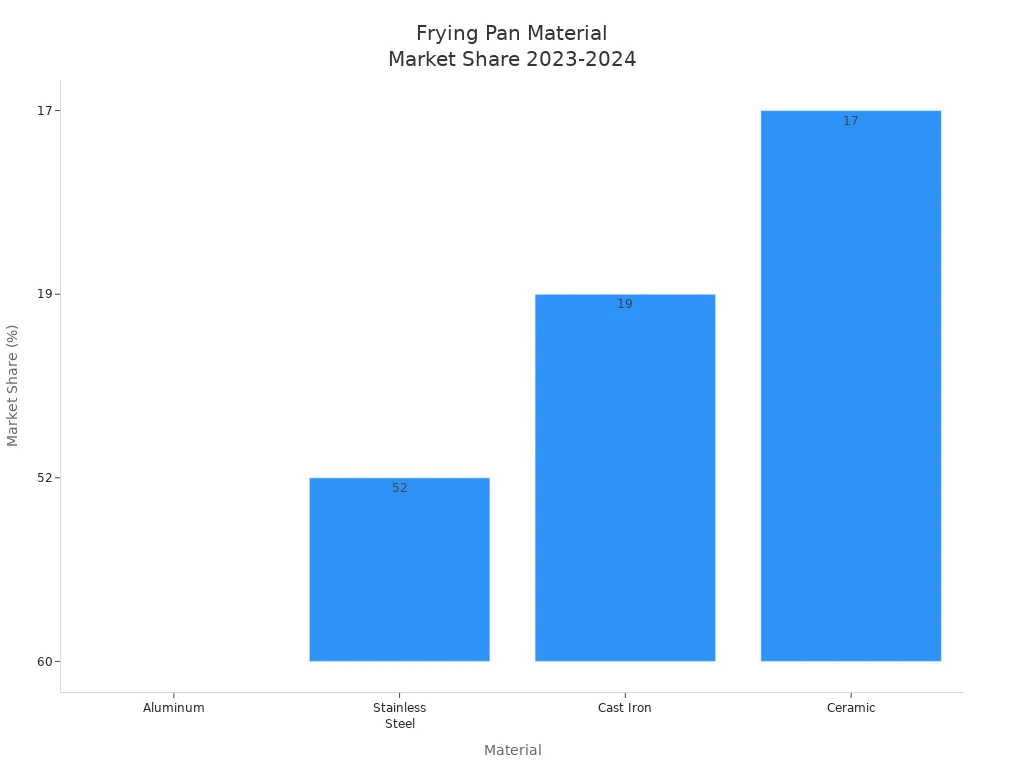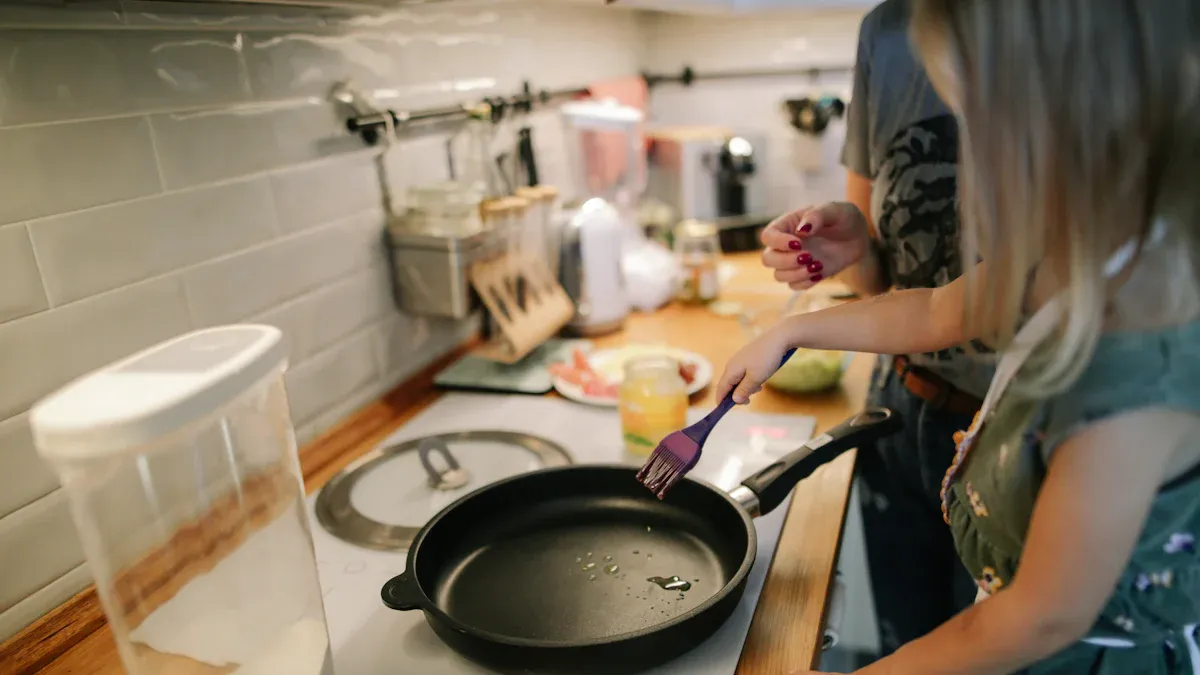
When selecting a frying pan, you want one that supports healthy cooking and fits your kitchen. The best frying pan combines durability, safety, and easy care. Choosing healthy cookware can prevent microplastics from entering your food:
- Non-plastic cookware avoids releasing microplastics.
- Plastic cookware increases microplastic contamination. A solid investment in the best frying pan gives you better meals and lasting value. Nonstick and stainless steel cookware also help with durability and performance.
Assessing Your Cooking Style and Frying Pan Needs
Everyday Cooking Habits
When you think about selecting a frying pan, start by looking at your everyday cooking habits. Do you cook quick breakfasts or prepare full dinners? Many home cooks use nonstick frying pans for eggs and pancakes. These pans help you cook with less oil and make cleanup easy. Stainless steel pans work well for browning and searing foods. Some people keep more than one type of frying pan to match different recipes and cooking needs.
- Nonstick pans (8 to 12 inches) are great for delicate foods and low-fat cooking.
- Stainless steel pans (8 to 14 inches) handle high heat and oven use.
- Hard-anodized pans offer durability and nonstick benefits for a range of dishes.
Types of Dishes You Prepare Most
The dishes you cook most often will guide your choice of cookware. If you love making eggs or pancakes, a nonstick frying pan around 8 inches works best. For sautéing vegetables or browning meats, you might prefer a stainless steel pan. The table below shows which frying pan fits common dishes:
| Dish Type / Cooking Method | Ideal Pan Size | Recommended Material | Reasoning / Notes |
|---|---|---|---|
| Eggs (single servings) | ~8 inches | Nonstick | Prevents sticking, perfect for delicate foods |
| Small vegetable sautés | ~8-10 inches | Nonstick or Stainless Steel | Even cooking without overcrowding |
| Sautéing | ~10 inches | Stainless Steel or Nonstick | Medium size for even heat and space |
| Multiple chicken breasts or pork chops | 12-14 inches | Stainless Steel | Larger surface for better browning and searing |
| Frying larger quantities | 12+ inches | Stainless Steel or heavy-duty | Accommodates more food, prevents spills |
| Baking or simmering | 10-14 inches | Oven-safe Stainless Steel | Holds more volume, suitable for oven use |

Number of People You Cook For
The size of your household affects your frying pan choice. If you cook for yourself, a small pan (8-10 inches) is enough. For a family, a medium pan (10-12 inches) gives you more space. Large families or people who cook in bulk often use pans over 12 inches. The table below helps you match frying pan size to your needs:
| Household Size | Preferred Frying Pan Size | Typical Pan Diameter (inches) | Usage Context and Preferences |
|---|---|---|---|
| Single-person/small | Small | 8-10 | Best for single servings or small portions |
| Small families/general | Medium | 10-12 | Versatile for everyday cooking and multiple servings |
| Large families/commercial | Large | Over 12 | Good for large quantities and big families |
Tip: Choose cookware that fits your stove and storage space. A well-matched frying pan makes cooking easier and more enjoyable.
Comparing Frying Pan Materials: Finding the Best Frying Pan
Choosing the best frying pan for your kitchen starts with understanding the materials. Each type of cookware offers unique benefits and drawbacks. You want to match your cooking style and health needs with the right frying pan material. The table below compares the most common frying pan materials for performance and safety:
| Cookware Type | Performance Characteristics | Safety Considerations |
|---|---|---|
| Cast Iron | Excellent heat retention; develops natural nonstick surface with seasoning; heavy; slow to heat and cool | Requires seasoning to prevent rust; not dishwasher safe; adds dietary iron; high maintenance |
| Carbon Steel | Good heat conductivity; develops natural nonstick when seasoned; lighter than cast iron; heats unevenly | Requires seasoning; can rust if not maintained; not dishwasher safe; reacts with acidic foods |
| Stainless Steel | Corrosion resistant; durable; non-reactive with food; good for sautéing with oil or liquid; dishwasher safe | Does not leach minerals; safe and long-lasting; may require oil to prevent sticking |
| Ceramic (100% ceramic) | Scratch resistant; slow and even cooking; safe for oven and stove (except induction); no chemical coatings | No chemical leaching; coating can chip if ceramic-coated; avoid metal utensils to prevent damage |
| Nonstick (Teflon) | Easy to clean; requires low to medium heat; coating can degrade over time | Contains chemicals (PFOA replaced by GenX) with potential toxicity; avoid high heat; replace if worn |
| Copper | Excellent heat conductivity; aesthetically pleasing; requires polishing; expensive | Can leach copper if unlined or coating damaged; excess copper intake harmful; high maintenance |
You can see that each frying pan material has strengths and weaknesses. Now, let’s look at each type in detail.
Non-Stick Frying Pan
A non-stick frying pan is popular for easy cooking and cleaning. You can cook eggs, pancakes, and fish without food sticking. Nonstick cookware lets you use less oil, which helps you prepare healthier meals. Most nonstick frying pans use a Teflon coating. This coating works best at low to medium heat. If you overheat the pan, the coating can break down and release fumes.
Tip: Always use wooden or silicone utensils with nonstick cookware to avoid scratching the surface.
Here is a quick look at the pros and cons:
| Advantages of Non-Stick Frying Pans | Disadvantages of Non-Stick Frying Pans |
|---|---|
| Requires less oil or fat, promoting healthier cooking. | Coating can scratch or flake off, especially with metal utensils. |
| Easy to clean due to food sliding off the surface. | Limited durability; surface wears off with frequent use. |
| Even heat distribution for consistent cooking. | Not suitable for high heat; can release harmful fumes if overheated. |
| Versatile for cooking delicate foods like eggs, pancakes, fish. | Potential health concerns from chemicals like PTFE and PFOA. |
| Reduces sticking and burning of food. | May not provide desired browning or searing effects. |
| Popular for hassle-free cooking and easy maintenance. | Requires careful handling to avoid damage (no metal utensils, harsh cleaners). |
| May have a shorter lifespan compared to traditional cookware. |
Nonstick cookware is affordable and lightweight. You should replace your non-stick frying pan if the coating starts to peel or scratch. Most nonstick cookware is not safe for high-heat cooking or oven use.
Stainless Steel Frying Pan
A stainless steel frying pan is a favorite for many home cooks. Stainless steel cookware is durable, corrosion-resistant, and dishwasher safe. You can use a stainless steel frying pan for browning, searing, and sautéing. Triply stainless steel pans have layers of aluminum or copper between the steel, which improves heat distribution.
Stainless steel frying pans last much longer than nonstick cookware. You can scrub them with steel wool without damage. They do not have a coating that wears out. You may need to use more oil to prevent sticking, but you get better browning and flavor. Stainless steel cookware does not leach minerals into your food, making it a safe choice.
Note: Triply stainless steel pans are especially popular in Europe and North America for their even heating and long life.
Cast Iron Frying Pan
A cast iron frying pan is known for its excellent heat retention. You can use it for searing steaks, baking cornbread, or frying chicken. Cast iron cookware develops a natural non-stick surface when you season it with oil. This natural non-stick surface improves with use.
Cast iron frying pans add iron to your food, which can help if you have low iron levels. However, too much iron can be a problem for some people. Acidic foods like tomatoes can increase iron leaching and damage the seasoning. You need to dry and oil your cast iron frying pan after each use to prevent rust.
| Aspect | Health Benefits | Health Drawbacks |
|---|---|---|
| Iron Contribution | Cast iron pans can add dietary iron to food, which may help combat iron deficiency anemia. | Excessive iron intake is a risk, especially for individuals prone to iron overload. |
| Iron Absorption | Vitamin C and acidic foods (e.g., tomatoes, lemon juice) can increase iron absorption from food cooked in cast iron. | Acidic foods increase iron leaching and may damage the pan’s seasoning, potentially leading to higher iron intake. |
| Pan Seasoning | Well-seasoned pans leach less iron, reducing potential risks. | Newer or less-seasoned pans leach more iron; cooking time and food type affect iron transfer. |
Cast iron cookware is heavy and requires more care than other types. You cannot put it in the dishwasher. With proper seasoning, you get a natural non-stick surface that lasts for generations.
Carbon Steel Frying Pan
A carbon steel frying pan is lighter than cast iron but still offers good heat retention. Carbon steel cookware heats up quickly and cools down fast, giving you more control. Like cast iron, carbon steel develops a natural non-stick surface with seasoning. Chefs often use carbon steel frying pans for stir-frying and searing.
You need to season your carbon steel frying pan to prevent rust. Carbon steel cookware can react with acidic foods, so avoid cooking tomatoes or vinegar-based dishes. Carbon steel is not dishwasher safe, but it is oven and broiler safe.
- Cast iron has the best heat retention, perfect for steady, high-heat cooking.
- Carbon steel balances heat retention with quick heating and cooling, making it easier to handle.
- Stainless steel heats evenly but does not retain heat as long as cast iron or carbon steel.
Tip: Carbon steel frying pans are ideal for high-heat cooking and quick temperature changes.
Ceramic Frying Pan
A ceramic-coated frying pan is a newer option in nonstick cookware. Ceramic cookware uses a mineral-based coating that does not contain PTFE or PFOA. You can use a ceramic-coated frying pan for low to medium heat cooking. It is easy to clean and does not leach chemicals into your food.
Ceramic-coated frying pans are scratch-resistant, but the coating can chip if you use metal utensils. The average lifespan of a ceramic frying pan is about 2 to 3 years. Once the coating wears out, you need to replace the pan. Ceramic cookware is popular for its eco-friendly appeal and chemical-free surface.
Note: Avoid using a ceramic-coated frying pan on high heat or with metal utensils to extend its life.
Copper Frying Pan
A copper frying pan stands out for its superior heat conductivity. Copper cookware heats up very quickly and responds instantly to temperature changes. This makes a copper frying pan perfect for recipes that need precise heat control. Most copper frying pans have a lining of stainless steel or tin to prevent copper from reacting with food.
| Material | Thermal Conductivity (W/m·K) | Heat Conductivity Characteristics |
|---|---|---|
| Copper | Much higher than 15 | Best heat conductor, heats rapidly and evenly, highly responsive to temperature changes, maintains thermal consistency |
| Stainless Steel | ~15 | Good heat conduction but significantly lower than copper, durable and corrosion resistant |
| Aluminum | Second only to copper | High conductivity, lightweight, but reactive unless treated or lined |
Copper cookware requires regular polishing to keep its shine. It is expensive and needs careful maintenance. If the lining wears off, copper can leach into your food, which is not safe. You should check your copper frying pan often to make sure the lining is intact.
Note: Copper frying pans are a favorite among professional chefs for their quick and even heating.

Aluminum, stainless steel, and cast iron frying pans lead the market in sales. Ceramic and copper frying pans are growing in popularity, especially among people who want eco-friendly or specialty cookware. Triply stainless steel and nonstick cookware remain top choices for many home cooks.
Choosing the Right Frying Pan Size and Shape

Common Frying Pan Sizes
When you shop for a frying pan, you will see several standard sizes. The most common diameters are about 7.9 inches, 10 1/4 inches, 11.8 inches, and 14 inches. Smaller pans, such as the 7.9-inch size, work well for frying eggs or cooking small portions. Medium pans, like the 10 1/4-inch and 11.8-inch options, suit steaks, chicken breasts, or vegetable sautés. If you often prepare meals for a group, a 14-inch frying pan gives you enough space for bigger servings. Experts suggest choosing a pan slightly larger than you think you need. This extra room helps prevent overcrowding and makes cooking easier.
Pan Depth and Shape
The depth and shape of your frying pan affect how your food cooks. You can pick from several designs:
- Sauté pans have deep, straight sides. These keep food inside and work well for sauce-based dishes, braising, and pan-roasting. Their flat bottoms help distribute heat evenly.
- Skillets feature sloped sides. You can flip and toss food easily, which is perfect for pancakes and eggs.
- Deep pans contain splatter and retain moisture, making them ideal for braises and pan sauces.
- Shallow pans allow faster evaporation and better browning, which helps when you want crispy or seared foods.
- Straight-sided pans hold heat and keep liquids from reducing too quickly.
- Sloped-sided pans make flipping and tossing easier, great for omelets or stir-fries.
Matching Size to Household Needs
You should match your frying pan size to the number of people you cook for. The table below shows expert recommendations:
| Pan Size | Diameter (inches) | Recommended Use | Household Cooking Needs |
|---|---|---|---|
| Small | ~8 | Single servings (one egg, few bacon strips) | Best for one person or small portions |
| Medium | ~10 | Meals for one to two people, versatile cooking | Good for small households or couples |
| Large | ~12 | Larger meals, multiple pieces of meat | Ideal for families or bigger portions |
| Extra Large | ~14 | Very large portions, entertaining guests | Suits larger families or parties |
You will get better results if you match pan size to food quantity. The right frying pan helps you cook evenly and efficiently.
Essential Frying Pan Features to Look For
Heat Distribution and Retention
When you choose a frying pan, you want even heat distribution. This helps your food cook evenly and prevents hot spots. Professional chefs look for cookware that keeps a steady temperature and heats up quickly. Laboratory tests show that thicker pans, like the de Buyer Mineral B Pro, hold heat better and keep the temperature steady. Thinner pans lose heat faster and can have big temperature differences between the center and the edge.
| Pan Model | Temp Difference (Center vs Edge, °F) | Heat Retention (Surface Temp After 5 min, °F) |
|---|---|---|
| Matfer Bourgeat | 9 | 149 |
| de Buyer Blue Carbon Steel | 75 | 126 |
| de Buyer Mineral B | 36 | 154 |
| de Buyer Mineral B Pro | 16 | 162 |

Copper and aluminum pans spread heat quickly and evenly. Cast iron and stainless steel hold heat longer, which is great for searing and browning.
Handle Design and Comfort
A good handle makes your frying pan easier and safer to use. Chefs recommend ergonomic, stay-cool handles that help you move the pan without burning your hand. Look for handles that feel comfortable and give you a firm grip. Some pans have slightly curved walls and rolled rims, which make flipping and pouring easier. These design features help you control your cookware and reduce the risk of spills.
Tip: Choose a frying pan with a handle that stays cool and feels balanced in your hand.
Oven and Dishwasher Safety
You may want to use your frying pan in the oven or clean it in the dishwasher. Many high-quality pans can handle both. Stainless steel, cast iron, and some nonstick pans are oven safe. Always check the manufacturer’s instructions for temperature limits. Dishwasher-safe cookware saves you time, but hand washing can help your pan last longer. Professional chefs often pick pans that are easy to clean and can go from stovetop to oven.
Cooktop Compatibility
Not all frying pans work on every cooktop. If you use an induction stove, you need cookware with a magnetic base. You can test this with a magnet—if it sticks, the pan will work. Cast iron, enameled steel, and multi-layered pans with magnetic stainless steel bases work on induction, gas, and electric cooktops. Aluminum and copper pans need a magnetic layer to work on induction. Flat bases help your pan heat evenly on any stove.
- Induction-compatible pans use magnetic stainless steel or cast iron.
- Multi-ply pans combine stainless steel with aluminum or copper for better heat distribution and versatility.
- Flat, stable bases improve performance on all cooktops.
Note: Always match your frying pan to your cooktop for the best cooking results.
Health and Safety Considerations for the Best Frying Pan
Non-Toxic and Chemical-Free Options
When choosing healthy cookware, you want to keep your meals safe. Many people look for non-toxic frying pans to support healthy cooking. Cast iron, carbon steel, and stainless steel pans are widely recognized as non-toxic. Some brands, like Lodge cast iron, meet strict Prop 65 standards for chemical safety. Ceramic-coated pans also offer a non-toxic surface, free from PFAS and PTFE. While some nonstick cookware claims to be non-toxic, always check for third-party testing or Prop 65 compliance. Pure ceramic, enameled cast iron, and food-grade stainless steel are good choices for non-toxic cookware. These options help you avoid harmful chemicals and make choosing healthy cookware easier.
Avoiding Harmful Coatings
You should know about the risks of some nonstick cookware coatings. Many nonstick pans use PFAS chemicals, including PTFE (Teflon). These coatings can release microplastics and nanoplastics if scratched or overheated. Health risks include:
- PFAS exposure may disrupt thyroid hormones and metabolism.
- Long-term use links to higher risks of cancer and heart disease.
- Heating nonstick cookware above 250°C releases toxic fumes.
- Scratched nonstick coatings can release microplastics into food and air.
To avoid these risks, follow these steps:
- Choose non-toxic cookware like cast iron, stainless steel, or ceramic-coated pans.
- Avoid nonstick cookware with PFAS or unknown coatings.
- Ask retailers about PFAS content before buying.
- Replace nonstick pans if the coating is scratched or flaking.
- Use wooden or silicone utensils to protect nonstick surfaces.
Choosing healthy cookware means picking pans without harmful coatings. Stainless steel and cast iron pans need seasoning and oiling, but they do not expose you to toxic chemicals.
Safe Use and Maintenance Tips
Safe use and care help you get the most from your non-toxic cookware. For cast iron, scrub with salt and hot water, then dry on the stove to prevent rust. Apply a thin layer of oil after drying. Stainless steel pans work best when preheated and oiled before cooking. Ceramic-coated pans should be cleaned gently to avoid chipping. Always wash your hands before and after handling food. Use separate cutting boards for raw meats and vegetables. Cook foods to safe temperatures to kill bacteria. Store your cookware in a dry place to prevent rust and contamination. These habits keep your non-toxic cookware safe and long-lasting.
Practical Tips for Frying Pan Care and Longevity
Cleaning and Storage
You can keep your frying pans in top shape by following a few simple steps. Always let your pan cool before washing. This prevents warping and keeps your cookware safe. For nonstick cookware, use mild dish soap and a soft sponge. Never use steel wool or harsh cleaners on nonstick surfaces. If you see burnt food, soak the pan in warm soapy water or use a baking soda paste. Copper pans need gentle cleaning and sometimes a polish to keep their shine. Stainless steel pans should be cleaned soon after use to avoid spots. Dry all pans well before storing them. To prevent scratches, place paper towels or pan protectors between stacked pans or hang them separately.
Seasoning and Maintenance
Seasoning helps cast iron and carbon steel pans last longer. You create a natural nonstick layer by baking oil into the surface. This layer stops food from sticking and protects against rust. After cleaning, dry your pan well and rub on a thin layer of oil. Over time, regular seasoning builds a strong patina. This makes your pan better for cooking and easier to clean. Carbon steel pans often need less upkeep than cast iron, but both benefit from steady care. Well-seasoned pans can last for generations and offer a great alternative to synthetic nonstick cookware.
When to Replace Your Frying Pan
You should check your pans for signs of wear. If you see scratches, chips, or the nonstick coating peeling, it is time to replace the pan. Food sticking to the surface, even after proper care, means the nonstick layer has worn out. Discoloration or warping can affect how your pan cooks. If you notice bad smells or residue that will not wash away, consider getting a new pan. Most nonstick cookware lasts about three to five years. Using damaged nonstick pans can release particles into your food, so always put safety first.
You find the best frying pan by matching durability, safety, and your cooking style. Experts suggest you look at material, pan size, handle comfort, and cooktop compatibility.
- Choose cookware that fits your needs.
- Pick the right size for your meals.
- Balance performance and convenience for lasting satisfaction.
FAQ
What frying pan material is safest for healthy cooking?
You get the safest results with stainless steel, cast iron, or ceramic. These materials do not leach chemicals or microplastics into your food.
How do you know when to replace your frying pan?
Check for peeling, warping, or sticking. If food burns or the coating flakes, you should buy a new pan.
Can you use metal utensils with nonstick frying pans?
You should avoid metal utensils. Use wood or silicone to protect the nonstick coating and extend your pan’s life.


